
The Himalayas of India: Ladakh and Dharamsala,
Summer 2008
Himachal Pradesh - A Tibetan Ex-Political Prisoner Speaks, Dharamkot, The Dalai
Lama Arrives, Tso Pema Lake
Page 14 of 16
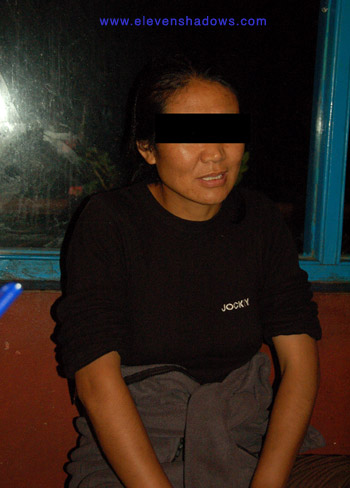 After
visiting Ronny and Rebecca's home, I walked to Khana Nirvana Cafe to listen
to an ex-political prisoner speak. Although this nun gave me her
permission to use her name and photo, I've refrained from doing so because
she still has family in Tibet. I shall call her Tsering Tsomebody.
This is her harrowing story, as translated by an employee of Khana Nirvana
Cafe: After
visiting Ronny and Rebecca's home, I walked to Khana Nirvana Cafe to listen
to an ex-political prisoner speak. Although this nun gave me her
permission to use her name and photo, I've refrained from doing so because
she still has family in Tibet. I shall call her Tsering Tsomebody.
This is her harrowing story, as translated by an employee of Khana Nirvana
Cafe:
Tsering Tsomebody was imprisoned at Gutse for jumping up on stage at a ceremony with several other nuns and shouting, "Long live the Dalai Lama!" and "Free Tibet!". She was beaten severely, interrogated at all hours of the day, and asked who the organizer was for two months. She was sentenced to 5 years imprisonment for being a "separatist" and transferred to Drapche Prison. She was forced to clean toilets and work in the field, and was beaten if she did not do so. Several years later, her and several other nuns in prison borrowed a tape recorder from a general prisoner, who were allowed to listen to music on Sundays. They bought cassettes from a shop when working outside in the greenhouses, and in the middle of the night, they secretly recorded songs to encourage younger people about freeing Tibet. However, the prison police discovered this and increased their sentences, hers by 4 more years. Rules became more restrictive, and the Army was brought in to torture them by having them stand in the shade in the freezing winter while holding books on their head. One day, another nun could no longer perform the rigorous tortures and fell. She was kicked repeatedly and brutally, and subsequently died from her injuries. Two nuns protested, so they were locked in small rooms where they couldn't stand and sentenced to stay there for 6 months, which would eventually render their limbs useless from atrophy. The other nuns protested by going on a hunger strike. Eventually, the guards held their arms and legs and forced food and water down their mouths, admonishing them, saying that they had to "care for their health." On 4 May 1998, Drapche Prison had a huge flag-raising ceremony in the center courtyard, celebrating the anniversary of their opening. Tibetans outside the prison protested. Several nuns, although not Tsering Tsomebody, tried to join in the protest by breaking windows and shouting "Free Tibet!!" Not surprisingly, these nuns were beaten in what Tsering describes as the worst beating she ever saw at Drapche. The nuns were struck repeatedly on their heads with rifle butts until the floor was soaked with blood. Eight died, and thirty received increased sentences. Those still alive were kept in locked rooms, and the guards took all their blankets and cushions from the room so they'd be cold. No family visitations were allowed (Tsering was allowed just one family visit every four months), and no water for bathing for one month. One day about a year after the flag-raising ceremony horror, a guard summoned Tsering and one other nun. The two nuns assumed that they would be tortured again. However, the guard simply said that they had served their sentence and could leave. That was it. Their families had not been contacted, so the two nuns simply left the prison, with no one to pick them up. Tsering went to her sister's house. Her sister was surprised, never knowing whether Tsering was even alive anymore. Her sister called the family. Everyone cried with happiness. Two days later, when Tsering had to meet with the police, she was told not to tell anyone what happened to her in Drapche. Although free from prison, things were still bad for Tsering. She could not get a job, and no one could help her because of her record as a political prisoner. People avoided her of fear of having the Chinese government associate them with a "separatist". Tsering realized that she had no choice but to leave Tibet to survive. After seven years of trying to create a life for herself in Tibet, she fled across the icy Himalayas to India in 2006, not knowing much other than that there were Tibetans and the Dalai Lama there. Tsering has called her family only twice before 10 March 2008. The last time she called, she was told by her family not to call again. It was not safe for her family to receive calls from her. She says that her dream is for Tibet to be completely free. She has no regrets about protesting. "I'm proud I could do something for my country. Since 1959, many Tibetans have sacrificed their lives to be free." Her Buddhist beliefs are unwavering. "I am very happy that the Dalai Lama met me and gave me his photo and a kata (silk scarf to show respect)." Tsering says that she hates the Chinese government, but not the people working in the prison who were simply carrying out orders. Tsering has heard of prisoners benefiting from letter-writing campaigns, but never has actually met anyone who benefited. She also states that currently, no therapists for ex-political prisoners are provided, but that Gu Chu Sum provides much assistance and Westerners speak to them to help them learn English. This is where I had chosen to volunteer, talking to help ex-political prisoners acquire English skills. Tsering receives medication for three years from the Tibetan government-in-exile. Unfortunately, the local hospital has not determined all her ailments yet, although she still has trouble with her kidneys. |
 28
July - I woke up late, and decided to walk to Dharamkot, walking up the
steep road through a lovely forest. 28
July - I woke up late, and decided to walk to Dharamkot, walking up the
steep road through a lovely forest.
There's even a synagogue there. A rabbi, deeply concerned that some of the Israelis might be "lost" and turn to Buddhism, decided to set up shop there. I walked up the road, asking where the synagogue was. This produced some funny looks, as one European said, "You don't look Jewish to me..." But no, my quest was for a restaurant near the synagogue that served excellent Israeli food. Dharamkot is jokingly referred to as "Little Tel Aviv", many of Israeli travelers choosing to stay here. I ate at Friendly Planet Restaurant near the Chabbat House, wolfing down a labene sandwich as I watched beautiful tanned people with explosions of curly brown hair laugh and talk through hazy clouds of pot smoke. A photo of "downtown" Dharamkot, with its plethora of Hebrew language signs. |
 My
labene sandwich took 45 minutes to come, so I bolted it down, then bolted
down the mountain to the Dalai Lama's temple, making it there in only 20
minutes. My
labene sandwich took 45 minutes to come, so I bolted it down, then bolted
down the mountain to the Dalai Lama's temple, making it there in only 20
minutes.What was the rush? The Dalai Lama was returning to Dharamsala after being overseas, and much of the town was turning out to see him. It began raining. Umbrellas went up. Suddenly, a motorcade. All umbrellas - whoooosh!! - instantly went down! people put their hands together in reverence and bowed. Then, whoosh!!! All the umbrellas snapped back up!! Almost as precise as a military exercise. Then the crowd dispersed while a few of us hid underneath an eave, talking about the events. Oddly, Tibetans were vehement about clearing the dogs from the road, even half an hour before the Dalai Lama was due to arrive. One Tibetan man kicked a dog repeatedly, causing it to whine, then went back to fingering his mala beads. I started to take some steps forward to stop him, and a foreigner stopped me and said it wasn't worth it. Another woman cleaned up dog poop from the road with her hands, throwing it in a trash can. It's difficult to judge what you don't understand, but this struck some of us foreigners as rather odd behavior from the usually extremely calm, peaceful, sweet Tibetans. I then joined a few people for dinner at Lung-Ta Japanese Vegetarian Restaurant, and afterwards, helped some Tibetan ex-political prisoners with their English at Gu Chu Sum. This was more challenging than usual because their English was *really* poor, and it's difficult to help someone speak when you can't figure out what they are saying. But they were diligent students, eager to learn, and grateful for us helping. The Tibetans that I have taught so far are quite motivated and eager to learn. |
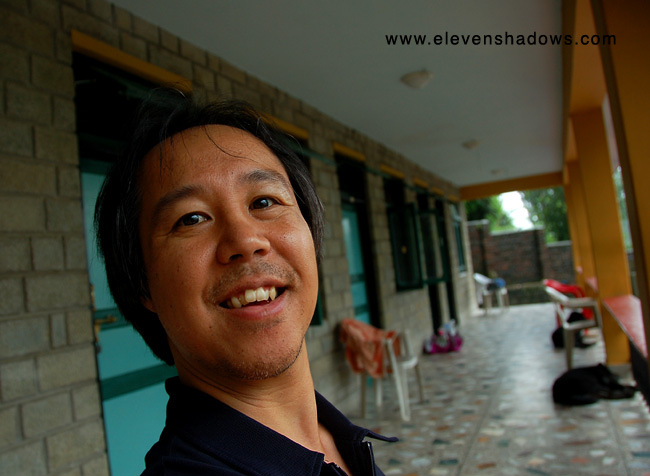 29
July - this was a lazy day, spent eating, reading, looking at the views, and
relaxing. 29
July - this was a lazy day, spent eating, reading, looking at the views, and
relaxing.~~~~ 30 July - Whoever said that Tso Pema (Rewalsar Lake, sometimes spelled Rawalsar) was only 5 hours away by bus was off the mark. It took 9 hours to get there. I got a room at the Drikung Kagyud Monastery for 200Rs. It rained continuously the entire time I was at Tso Pema, but I didn't let that dampen my spirits. After eating thanthuk (noodle soup) with fried egg, I relaxed on the balcony in front of my room with two black monastery dogs (right side of photo in the distance). |
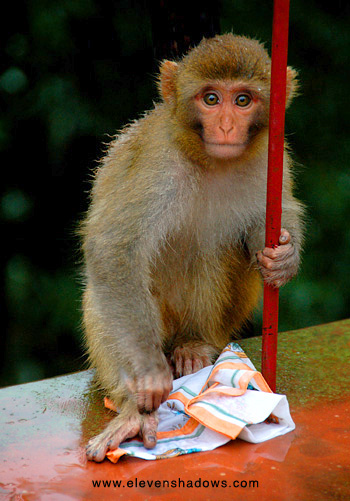 Although
still raining and foggy, I walked around anyway, visiting the temple first.
I tucked the camera inside my waterproof jacket as I had done at Hemis
Monastery, and walked around with a small umbrella I had purchased in McLeod
Ganj. Although
still raining and foggy, I walked around anyway, visiting the temple first.
I tucked the camera inside my waterproof jacket as I had done at Hemis
Monastery, and walked around with a small umbrella I had purchased in McLeod
Ganj.One of the monkeys at Drikung Kagyud Monastery, near the temple. |
 Drikung
Kagyud Temple within the monastery complex. Drikung
Kagyud Temple within the monastery complex. |
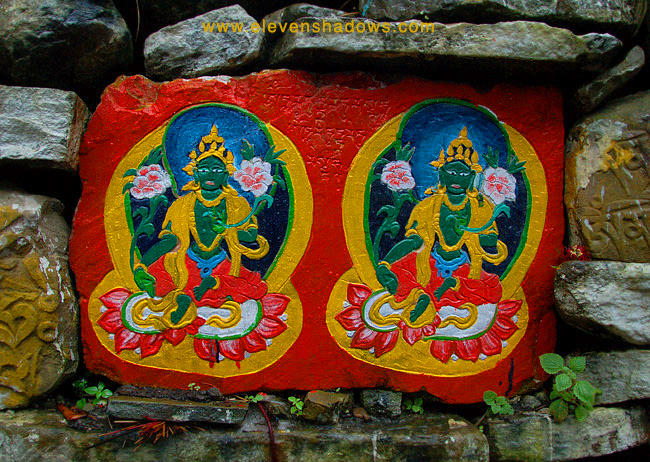 After
visiting the Drikung Kagyud Monastery, I began wandering around Tso Pema
(Rewalsar Lake), still with umbrella in hand and my camera underneath my
jacket. I watched monkeys dart around, being shooed away by the food
vendors, and devout pilgrims - Tibetans, Sikhs, Hindus - circumambulating
the lake and visiting their respective temples. After
visiting the Drikung Kagyud Monastery, I began wandering around Tso Pema
(Rewalsar Lake), still with umbrella in hand and my camera underneath my
jacket. I watched monkeys dart around, being shooed away by the food
vendors, and devout pilgrims - Tibetans, Sikhs, Hindus - circumambulating
the lake and visiting their respective temples. |
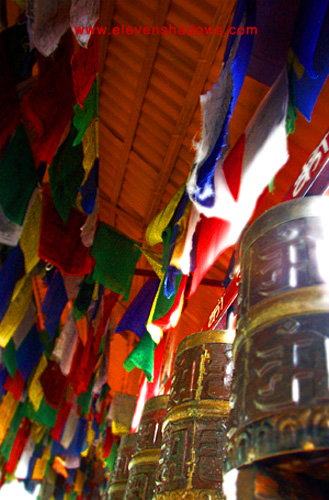 Prayer
wheels wrap around a temple with a statue of Pabmasambhava, or Guru
Rinpoche, and offer beautiful views of the lake...at least, when it's not
foggy. Prayer
wheels wrap around a temple with a statue of Pabmasambhava, or Guru
Rinpoche, and offer beautiful views of the lake...at least, when it's not
foggy. |
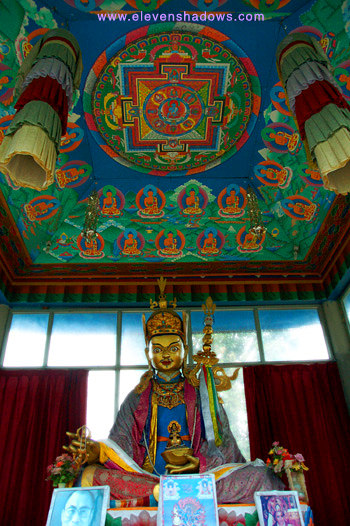 From
around 640 to 842 AD, Tibet was in a phase of expansion during which it
absorbed substantial Chinese, Nepalese and other territories surrounding it.
It was near the end of this period that the first Tibetan Buddhist monastery
was founded at Samye. From
around 640 to 842 AD, Tibet was in a phase of expansion during which it
absorbed substantial Chinese, Nepalese and other territories surrounding it.
It was near the end of this period that the first Tibetan Buddhist monastery
was founded at Samye.According to Tibetan lore, local deities and demons opposed to the introduction of Buddhism, destroyed every at night what was being built during the day. The Tibetan emperor at the time, concerned, consulted Santarakshita, the Indian monastic who was going to be the first abbot of the new monastery. His advice was to summon the great adept Padmasambhava from India to tame local deities and bind them to the service of Buddha-dharma. Padmasambhava left for Tibet from Tso Pema (Rewalsar Lake) and journeyed through Tibet, subduing these forces, and these feats making up the legendary core of accounts of his life. These events, mythical, legendary or historical, have consequences for practitioners of Tibetan Buddhism today since they determine the way in which these beings are perceived and treated, in visualization, the making of representations and in other practices. Then, too, his other significance in Tibetan Buddhism, and the reason he is referred to as Guru Rinpoche, is that he is regarded as the "second Buddha" of this age. |
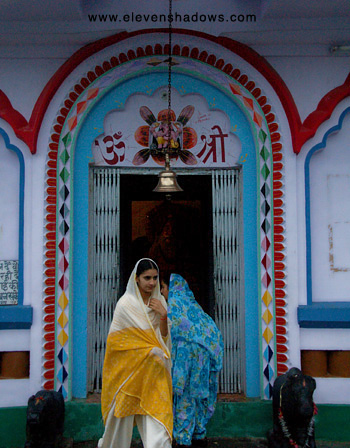 Rewalsar
Lake (Tso Pema to Tibetan Buddhists), as the Hindus call it, is also
associated with several mythological tales involving Shiva and the Rishi
Lomas, with several temples dedicated to them and to Krishna. Rewalsar
Lake (Tso Pema to Tibetan Buddhists), as the Hindus call it, is also
associated with several mythological tales involving Shiva and the Rishi
Lomas, with several temples dedicated to them and to Krishna. |
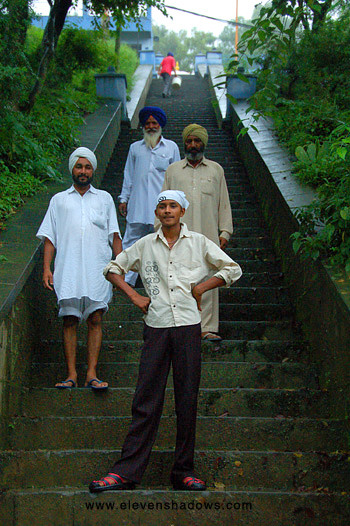 The
tenth Guru of Sikhs, Guru Gobind Singh, visited Rewalsar Lake to consult with
kings of the Hill states, seeking support against Aurangzeb. He stayed at
Rewalsar for a month. Raja Joginder Sen of Mandi built a large blue
gurudwara (Sikh temple) at Rewalsar Lake in 1930 to commemorate the Guru's
visit. The
tenth Guru of Sikhs, Guru Gobind Singh, visited Rewalsar Lake to consult with
kings of the Hill states, seeking support against Aurangzeb. He stayed at
Rewalsar for a month. Raja Joginder Sen of Mandi built a large blue
gurudwara (Sikh temple) at Rewalsar Lake in 1930 to commemorate the Guru's
visit. |
 At
once garish and beautiful, the enormous 122-ft. statue of Padmasambhava
towers over the lake at Tso Pema. At
once garish and beautiful, the enormous 122-ft. statue of Padmasambhava
towers over the lake at Tso Pema.
A day or two after visiting Tso Pema, when I was volunteering at Gu Chu Sum and teaching English to ex-political prisoners Palden and Nyima, I told them that I had just visited Tso Pema. Although supremely challenging due to our language barrier, they managed to tell me this legend of Padmasambhava, making me very happy and proud of their efforts: The king of the nearby town of Mandi had Padmasambhava burnt alive after rumors that the Guru had attempted to teach his daughter, Princess Mandarava, the Dharma, which was not accepted then. The pyre burned for a full week, After a week, a lake appeared at the spot where he was burnt and Padmasambhava appeared from within a lotus in the middle of the lake. The king, repenting his actions, consented to have his daughter marry Padmasambhava. Padmasambhava then left from Tso Pema for to Tibet to spread Vajrayana Buddhism. From this legend the lake became known as Tso Pema, or Lotus Lake. |
 This
is the view of the extremely foggy Tso Pema (Rewalsar Lake) from the base of
the enormous Padmasambhava statue. This
is the view of the extremely foggy Tso Pema (Rewalsar Lake) from the base of
the enormous Padmasambhava statue. |
 Another
view of the imposing statue of Padmasambhava. Another
view of the imposing statue of Padmasambhava.Lama Wangdor has been meditating in the same caves near Tso Pema used by Padmasambhava for over thirty years. Several years ago, he began constructing a massive Padmasambhava statue and center in the hills overlooking the lake. The generous donations of many people within the Dharma community have allowed this construction project to make much progress, even though it will take years to complete. The statue's foundation alone has taken three years to construct, and the construction still continues. |
 Back
at Drikung Kagyud Monastery, a monk burns manuscripts in a sort of Buddhist
chiminea, with the 122 ft. Padmasambhava statue looking on from the other
side of the lake. Back
at Drikung Kagyud Monastery, a monk burns manuscripts in a sort of Buddhist
chiminea, with the 122 ft. Padmasambhava statue looking on from the other
side of the lake. |
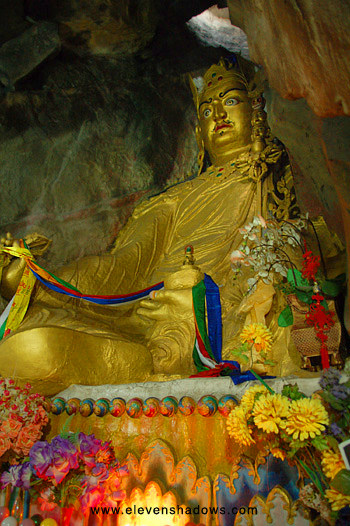 I
had a very deep peaceful sleep...until 6:30, when I woke to crashing Tibetan
cymbals, drums, and chanting from the monastery. It was time to get up.
Although there was a 10am bus to Padmasambhava's cave, I chose to take a
return taxi up so I could have the place to myself and also get back to
Dharamsala at a decent hour. This ended up working out superbly, as I was
literally the only one at the cave. I
had a very deep peaceful sleep...until 6:30, when I woke to crashing Tibetan
cymbals, drums, and chanting from the monastery. It was time to get up.
Although there was a 10am bus to Padmasambhava's cave, I chose to take a
return taxi up so I could have the place to myself and also get back to
Dharamsala at a decent hour. This ended up working out superbly, as I was
literally the only one at the cave.This is the statue of Padmasambhava inside the cave. |
The Himalayas of India: Ladakh and Dharamsala, Summer 2008
Page 14 of 16
1 2 3 4 5 6 7 8 9 10 11 12 13 14 15 16
Eleven Shadows Travel Page
Contact photographer/musician Ken Lee